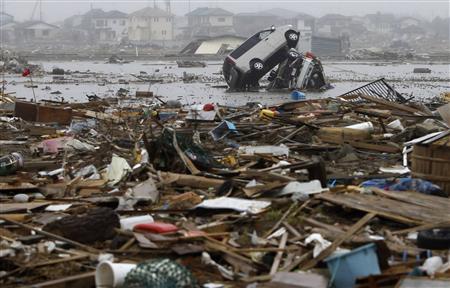Japan's cabinet approved on Friday almost $50 billion of spending for post-earthquake rebuilding, a downpayment on the country's biggest public works effort in six decades.
The emergency budget of 4 trillion yen ($48.5 billion), which is likely be followed by more reconstruction spending packages, is still dwarfed by the overall cost of damages caused by the March 11 earthquake and tsunami, estimated at $300 billion.
"With this budget, we are taking one step forward toward reconstruction ... and toward restarting the economy," Finance Minister Yoshihiko Noda told reporters after a cabinet meeting.
Unpopular Prime Minister Naoto Kan, under fire for his handling of the crisis, said Japan would have to issue fresh government bonds to fund extra budgets to come, and suggested he would stay on to oversee the process.
"I feel it was my destiny to be prime minister when the disasters and nuclear accident took place," Kan told a news conference.
"I want to work for reconstruction and rebuilding, and present an outline to overcome these two crises. To have that vision in sight is my heartfelt desire as a politician."
Financing the next packages will be much tougher, as they are likely to involve a mix of taxes as well as borrowing in the bond market, which could strain Japan's debt-laden economy.
If Kan is unable to steer those laws through parliament, he may be forced to step down, analysts say.
The magnitude 9.0 earthquake and 15-meter (50-ft) tsunami that followed caused Japan's gravest crisis since World War Two, killing up to 28,000 people and destroying tens of thousands of homes.
It also smashed a nuclear power plant which began leaking radiation, a situation the plant's operator says could take all year to bring under control.
The budget will be submitted to parliament next week and is expected to be enacted in May.
"CAUSED GREAT TROUBLE"
Prime Minister Kan, who has been accused by opposition politicians, his own party and quake survivors of failing to take command of the response to the triple disaster, has said the need to rebuild is an opportunity for national "rebirth."
A Jiji news agency opinion poll showed Kan's support rate stood at 20.5 percent, up a scant 1.6 points from the previous month, with more than three out of four voters saying he had exercised little or no leadership over the nuclear crisis.
About 57 percent said they were supportive of a tax rise to finance reconstruction compared with 38.6 percent who were not.
In a Reuters poll of retail investors released on Friday, 83 percent of those surveyed said they disapproved or strongly disapproved of the administration's handling of the crisis.
As well as trying to rebuild the ruined northeast of the country, Japan also has to contend with the world's worst nuclear crisis since the 1986 Chernobyl disaster, the wrecking of the Fukushima Daiichi plant, 240 km (150 miles) from Tokyo.
Radiation spilled out from the facility after a hydrogen explosion, and in their battle to cool melting fuel rods, engineers pumped radioactive water into the Pacific, a move that worried Japan's neighbors about the spread of contamination.
Masataka Shimizu, the much-criticised president of plant operator Tokyo Electric Power (TEPCO), visited an evacuation center for the first time since the disaster struck, kneeling and bowing deeply to the evacuees.
"I want to work hard so that you can go home," he said. Mostly subdued evacuees pleaded with him to bring the crisis to an end so they could go home. "I want you to act as if it had happened to your own family," said one man.
Earlier, dressed in blue work clothes, Shimizu apologized to Fukushima's regional governor, Yuhei Sato.
"I apologize from the bottom of my heart for the great trouble caused to many people in society," he said.
Shimizu's company has been accused of downplaying the dangers and ignoring warnings about the risk of a quake and tsunami striking the plant, as well as reacting poorly to the damage.
Japan said this week it would ban anyone entering a 20-km (12-mile) evacuation zone around the plant.


No comments:
Post a Comment